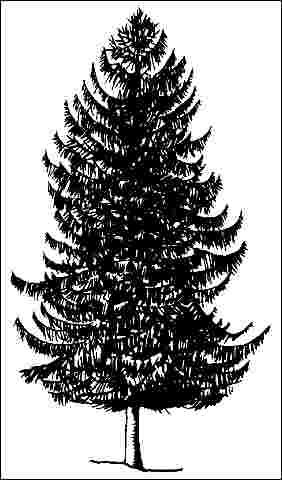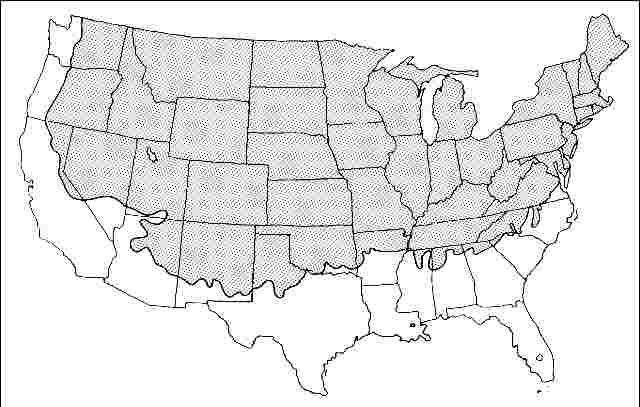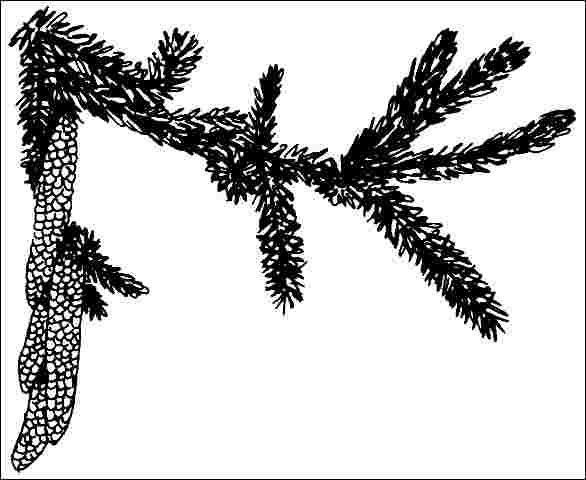Introduction
Norway Spruce can grow 80 to 100 feet tall and spread 25 to 40 feet, though some listed cultivars are shrublike. Small-diameter branches sweep horizontally from the straight trunk which can grow to four feet thick. Branchlets droop from the branches toward the ground in a graceful, weeping fashion forming a delicate pyramid. On very old specimens the lower branches increase to 12" or more in diameter and the top becomes open. Many small-diameter roots originate from the base of the trunk and they are often found fairly close to the surface of the soil. The root system is shallow and often dense, particularly close to the trunk which makes growing grass difficult.

General Information
Scientific name: Picea abies
Pronunciation: PIE-see-uh AY-beez
Common name(s): Norway Spruce
Family: Pinaceae
USDA hardiness zones: 2B through 7A (Fig. 2)
Origin: not native to North America
Invasive potential: little invasive potential
Uses: specimen; screen
Availability: not native to North America

Description
Height: 80 to 100 feet
Spread: 25 to 40 feet
Crown uniformity: symmetrical
Crown shape: pyramidal
Crown density: moderate
Growth rate: slow
Texture: fine
Foliage
Leaf arrangement: alternate (Fig. 3)
Leaf type: simple
Leaf margin: entire
Leaf shape: needle-like (filiform)
Leaf venation: parallel
Leaf type and persistence: evergreen, needled evergreen
Leaf blade length: less than 2 inches
Leaf color: green
Fall color: no color change
Fall characteristic: not showy

Flower
Flower color: pink
Flower characteristics: not showy
Fruit
Fruit shape: oval, elongated, cone
Fruit length: 3 to 6 inches
Fruit covering: dry or hard
Fruit color: brown
Fruit characteristics: does not attract wildlife; showy; fruit/leaves not a litter problem
Trunk and Branches
Trunk/bark/branches: branches droop; not showy; typically one trunk; thorns
Pruning requirement: little required
Breakage: resistant
Current year twig color: brown
Current year twig thickness: medium
Wood specific gravity: unknown
Culture
Light requirement: full sun
Soil tolerances: clay; sand; loam; acidic; slightly alkaline; well-drained; occasionally wet
Drought tolerance: moderate
Aerosol salt tolerance: moderate
Other
Roots: not a problem
Winter interest: no
Outstanding tree: no
Ozone sensitivity: tolerant
Verticillium wilt susceptibility: resistant
Pest resistance: sensitive to pests/diseases
Use and Management
Norway Spruce is best used as a specimen in a lawn area or as a wind break or screen, planted on 20-foot-centers. Rockefeller Center in New York City erects a Norway Spruce each Christmas next to the skating rink and decorates it for the holiday season.
Norway Spruce tolerates most soils if moist and transplants easily if balled and burlapped or potted. Trees subjected to drought are much happier if they receive periodic irrigation although they tolerate drought well. There are a number of cultivars of Norway Spruce. Some are dwarf and shrublike, while others are trees. Not all will be available in nurseries. Cultivars include: `Clanbrasiliana' - dwarf, about four feet tall and twice as wide; `Columnaris' - narrow, columnar; `Echiniformis' (Hedgehog Spruce) - a rounded dwarf, broad; `Gregoryana' - rounded, broad, about three feet tall but much wider, slow-growing; `Humulis' - about two feet tall; `Inversa' - 40 to 50 feet tall, drooping habit; `Maxwelli' - four feet tall and 10 feet wide, slow-growing, dense; `Nidiformis' - dwarf, very dense mound; `Nigra' - densely branched, dark green; `Pendula' - weeping; `Procumbens' - flat, dense, can be three feet tall; `Pumila' - spreading, about four feet tall; `Pygmea' - conical, slow-growing; `Pyramidata' - narrow, slender pyramid; `Reflexa' - branchlets pendulous, one foot high but 10 feet wide; `Repens' - flat and prostrate, less than three feet tall but quite wide; `Stricta' - slender, spirelike, 40 to 50 feet tall, eight feet wide.
Pests
Mites are the worst problem, and in hot weather they can build to populations which require control. They can be a major problem in summer after hot dry weather, especially near concrete, buildings, and other urban surfaces which reflect heat. The small insects can't be readily seen with the naked eye. The first noticeable symptoms are yellowing at the base of the oldest needles on infested branches. Close inspection with a magnifying glass will confirm the presence of the mites.
Two gall-forming insects commonly attack Spruce. Eastern Spruce gall adelgid forms pineapple like galls at the base of twigs. Galls caused by Cooley's Spruce gall adelgid look like miniature cones at the branch tips. The gall adelgids do not kill trees unless the infestation is heavy. A few galls on a large tree are not serious.
Bagworms make a sack by webbing needles and debris together. Small numbers may be picked off by hand or use Bacillus thuringiensis .
In northern climates, Spruce budworm larvae feed on developing buds and young needles. The yellowish brown caterpillars are difficult to see.
The Spruce needle miner makes a small hole in the base of a needle then mines out the center. Dead needles are webbed together and can be found on infested twigs. Hand pick these from the tree to reduce future damage.
Pine needle scale is a white, elongated scale found feeding on the needles only. Populations would have to be quite high to cause major damage.
Sawfly larvae may feed on the needles. One infestation will usually not kill the tree, but there may be two or more generations per year.
Borers can infest trees which are weakened by other problems.
Diseases
Cytospora canker infects a branch then eventually kills it. The lower branches are attacked first then progressively higher branches. The needles turn brown to reddish brown and eventually drop off. White resin patches are seen on infected branches. Prune off infected branches. Water Spruces during dry weather.
Spruce may be attacked by needle casts. One causes needles to turn yellow or brown and drop off. Another affects the lowest needles first then moves up the tree. Infected needles are a mottled yellow.
Several rust diseases attack Spruce but these are rarely seen. Infected needles turn yellow and drop off.